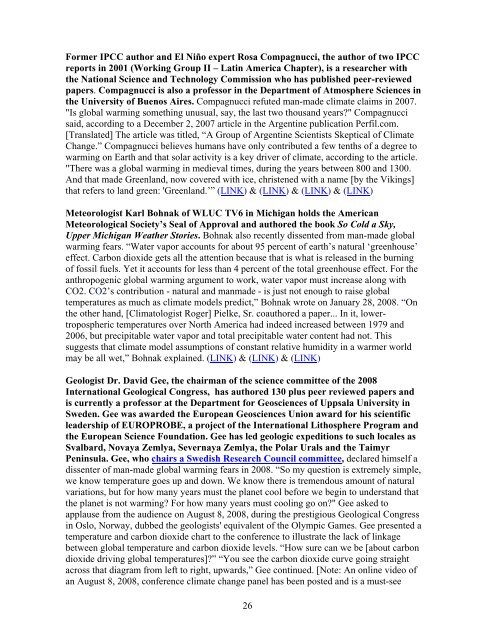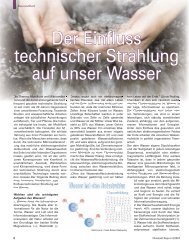U. S. Senate Minority Report: - Klimaforschung
U. S. Senate Minority Report: - Klimaforschung
U. S. Senate Minority Report: - Klimaforschung
You also want an ePaper? Increase the reach of your titles
YUMPU automatically turns print PDFs into web optimized ePapers that Google loves.
Former IPCC author and El Niño expert Rosa Compagnucci, the author of two IPCC<br />
reports in 2001 (Working Group II – Latin America Chapter), is a researcher with<br />
the National Science and Technology Commission who has published peer-reviewed<br />
papers. Compagnucci is also a professor in the Department of Atmosphere Sciences in<br />
the University of Buenos Aires. Compagnucci refuted man-made climate claims in 2007.<br />
"Is global warming something unusual, say, the last two thousand years?" Compagnucci<br />
said, according to a December 2, 2007 article in the Argentine publication Perfil.com.<br />
[Translated] The article was titled, “A Group of Argentine Scientists Skeptical of Climate<br />
Change.” Compagnucci believes humans have only contributed a few tenths of a degree to<br />
warming on Earth and that solar activity is a key driver of climate, according to the article.<br />
"There was a global warming in medieval times, during the years between 800 and 1300.<br />
And that made Greenland, now covered with ice, christened with a name [by the Vikings]<br />
that refers to land green: 'Greenland.’” (LINK) & (LINK) & (LINK) & (LINK)<br />
Meteorologist Karl Bohnak of WLUC TV6 in Michigan holds the American<br />
Meteorological Society’s Seal of Approval and authored the book So Cold a Sky,<br />
Upper Michigan Weather Stories. Bohnak also recently dissented from man-made global<br />
warming fears. “Water vapor accounts for about 95 percent of earth’s natural ‘greenhouse’<br />
effect. Carbon dioxide gets all the attention because that is what is released in the burning<br />
of fossil fuels. Yet it accounts for less than 4 percent of the total greenhouse effect. For the<br />
anthropogenic global warming argument to work, water vapor must increase along with<br />
CO2. CO2’s contribution - natural and manmade - is just not enough to raise global<br />
temperatures as much as climate models predict,” Bohnak wrote on January 28, 2008. “On<br />
the other hand, [Climatologist Roger] Pielke, Sr. coauthored a paper... In it, lowertropospheric<br />
temperatures over North America had indeed increased between 1979 and<br />
2006, but precipitable water vapor and total precipitable water content had not. This<br />
suggests that climate model assumptions of constant relative humidity in a warmer world<br />
may be all wet,” Bohnak explained. (LINK) & (LINK) & (LINK)<br />
Geologist Dr. David Gee, the chairman of the science committee of the 2008<br />
International Geological Congress, has authored 130 plus peer reviewed papers and<br />
is currently a professor at the Department for Geosciences of Uppsala University in<br />
Sweden. Gee was awarded the European Geosciences Union award for his scientific<br />
leadership of EUROPROBE, a project of the International Lithosphere Program and<br />
the European Science Foundation. Gee has led geologic expeditions to such locales as<br />
Svalbard, Novaya Zemlya, Severnaya Zemlya, the Polar Urals and the Taimyr<br />
Peninsula. Gee, who chairs a Swedish Research Council committee, declared himself a<br />
dissenter of man-made global warming fears in 2008. “So my question is extremely simple,<br />
we know temperature goes up and down. We know there is tremendous amount of natural<br />
variations, but for how many years must the planet cool before we begin to understand that<br />
the planet is not warming? For how many years must cooling go on?" Gee asked to<br />
applause from the audience on August 8, 2008, during the prestigious Geological Congress<br />
in Oslo, Norway, dubbed the geologists' equivalent of the Olympic Games. Gee presented a<br />
temperature and carbon dioxide chart to the conference to illustrate the lack of linkage<br />
between global temperature and carbon dioxide levels. “How sure can we be [about carbon<br />
dioxide driving global temperatures]?” “You see the carbon dioxide curve going straight<br />
across that diagram from left to right, upwards,” Gee continued. [Note: An online video of<br />
an August 8, 2008, conference climate change panel has been posted and is a must-see<br />
26





